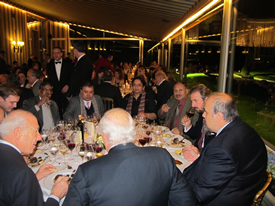 Dinner with Wine is exactly what it says- a dinner where wine is served with the dinner. Usually, the host orders the wine/s after ascertaining the type of food being ordered. Before the dinner is served, he or she may order an aperitif wine like champagne, any bubbly, or a light white wine or even a Rose. If the dishes ordered for the meals follow a wide spectrum of flavours and textures, the host may order both a white and a red wine. Otherwise, one wine that may have a common thread with all the dishes may be more economical. Of course, there may be a glass of beer here and a glass of cola, juice or a mocktail there for the teetotalers at such dinners. Dinner with Wine is exactly what it says- a dinner where wine is served with the dinner. Usually, the host orders the wine/s after ascertaining the type of food being ordered. Before the dinner is served, he or she may order an aperitif wine like champagne, any bubbly, or a light white wine or even a Rose. If the dishes ordered for the meals follow a wide spectrum of flavours and textures, the host may order both a white and a red wine. Otherwise, one wine that may have a common thread with all the dishes may be more economical. Of course, there may be a glass of beer here and a glass of cola, juice or a mocktail there for the teetotalers at such dinners.
Wine Dinner
A wine dinner on the other hand is explicitly well structured and follows a certain regimen decided by the organizers. It would usually be a sit-down dinner with wines paired with individual dishes. The order of serving of wines is not changeable and the guests are ‘encouraged’ to stick to that sequence. The winemaker, sommelier or the person conducting the Wine Dinner would talk about each wine either as is served or talk about two-three at a time. The talk could be highly technical or general, depending on the level of knowledge and the interest and curiosity among the guests.
The wines could be disclosed to the guests or could be served ‘blind’, making it interesting for people to guess the wines. They may be procured by the organizers or each member can bring a bottle or two. There are educational talks about the wines being served, if they are not ‘blind’. I met a lady in London recently whose husband is a known writer and they are both members of a small, elitist wine club. She had come to Berry Bros. and Rudd to buy a couple of bottles for ‘blind’ tasting. She claimed that she could usually call the wines correctly including the name of wineries producing it-this was for high quality French wines, generally. According to her, it was the regular practice at such wine dinners and kept the tasting prowess of a person sharp.
It is optional whether additional wine is allowed to the guests in addition to what is poured as the standard servings. For commercial ventures, the organizers might keep a tight control on the amount served per person to reduce the costs. At the wine dinners at the Delhi Wine Club which has enjoyed 227 such dinners since it was founded in 2002, about 90mL of wine is poured (8.5 glasses to a 750- mL bottle) at the first instance and refills are allowed for most labels. This is to avoid wastage of wines which are very expensive to procure. For dinners at the wineries or several other venues overseas, this may not be as critical.
For finer wines, the amount served at the first instance may be even smaller, as low as 60 mL- that is, a bottle is enough for 12-13 people. If the number of different wines served is limited, the quantity may be increased to 125 mL (6 glasses) or even 150mL (5 glasses a bottle). However, the order of service is never changed- generally going from sparkling/light wine to fuller- bodied white, Rose and then Red again from lighter to fuller bodied wine. Younger wines are served before the older vintages. Usually bottles are not kept at the table for service except when requested for reading the contents of the labels and other information about the wine being poured.
There are generally no spittoons and the glasses are changed, with the glasses with left-over wine removed regularly. Naturally, the only beverage served at a wine dinner is wine. Most dinners organized by clubs or other wine groups and wineries to promote their wines are in this category with wines served numbering from 3-7; but 4-5 labels is more of a norm.
Gala Wine Dinners
Many dinners are positioned to enable guests to drink a multiple number of wines to give them an opportunity to taste more wines. These are additional to the wines specified in the Menu. There may be dinners where they serve 8-12 wines but the total number of wines offered may go up to even a 100. In these cases, the guest has a list of all wines accessible along with the numbers ascribed to each wine and the sommelier may bring these wines to the table. It may then be tasted by one or everyone at the table. The bottles may be kept on the table for such dinners. Also, it is not mandatory to drink what’s in the glass. Spittoons are available on each table to empty the glasses even after one sip. Etiquettes dictate that one does not spit the wine from the mouth directly into the spittoon. Only glasses with unwanted wine may be emptied into them. One may end up tasting and drinking 10-20 wines during the course of a dinner.

For instance, dinners organized by the Tuscan Consortiums (Chianti Classico, Vino Nobile di Montepulciano and Brunello di Montalcino) at various venues offer wines that could well run into a hundred for each such dinner. At World Wine Symposium held every November at Villa d’Este, there are different wines for different dinners-numbering to 6 or more on the Menu. But the organizers encourage the producer participants to bring their wines and have guests on different tables taste them. One could have over 20 wines with the dinner-most wines being for tasting and the guest choosing the most palatable one with the course. But once again, wine is the only beverage served though a grappa. Cognac or brandy may be there to finish off with coffee or tea.
We encourage our readers to try having dinner with wine as often as feasible but wine dinners are the best options to enjoy as you learn about wines as you enjoy the experience. Taj Hotels, Oberoi, Claridges Delhi, ITC Maurya, Leela Gurgaon, Westin Gurgaon are but a few of the hotels that have either their own wine clubs or a dedicated list of members who are invited to these events regularly. This is the best way of enjoying several wines with dinner, without burning a hole in the pocket.
Of course, you can always enjoy dinner at any place with a glass or two of different wines. Your sommelier ought to help you in selecting these wines.
Subhash Arora |